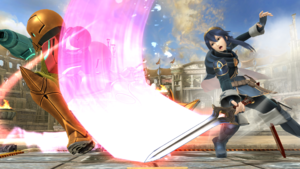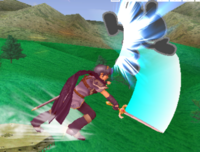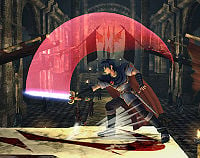Dancing Blade
| Dancing Blade | |
|---|---|
 The first strike of Lucina's Dancing Blade in Smash 4. | |
| User | Marth Lucina |
| Universe | Fire Emblem |
| “ | A combo that you can change by sliding |
” |
| —Smash for 3DS's foldout | ||
Dancing Blade (マーベラスコンビネーション, Marvelous Combination) is Marth and Lucina's side special move. It is a unique special move, as it consists of four different attacks chained together; a variety of combos can be performed depending on one's tilt on the control stick or d-pad for each attack. This makes it one of exceptionally few attacks in the Super Smash Bros. series which relies on this type of input - most attacks require only one direction.
The options on the tilts lead to 18 possible combinations by adjusting the tilt in subsequent attacks, as there is always the standard attack, followed by the second, third, and fourth attack. The first, standard attack is utilized by the executing a forward special. The second attack has two options: up and forward, and the third and fourth have three options: up, forward, and down.
In Super Smash Bros. Melee
In Melee, the first attack is often used to gain horizontal recovery. Also, Marth will glow a color as he uses his attacks. For the first attack, he will glow red; the second, green; the third, blue; and for the last one, red again. It is quite unlikely that Marth would have to use all four attacks, since both the third and fourth strikes have much higher knockback than the first and second. It is rather difficult to pull off the full attack, as the attack requires timing on each blow to follow up.
Roy's Double-Edge Dance is a variant of this attack.
In Super Smash Bros. Brawl
Dancing Blade has seen quite a few changes since Melee. Unlike in Melee, Marth doesn't glow anymore when using this attack. The attacks simply change the motion trail of his sword. The colors are more coordinated, with Red always representing neutral, Blue always representing up, and Green always representing down. Secondly, the timing no longer matters, so it can be performed easily. If the first hit connects, it is nearly impossible to escape the rest of the combo when the timing is fast enough. The knockback on the third strike is decreased, allowing for better combos. The final can either be 2 KO moves at high percentages (Up can KO at 118% tipped, 142% base. Forward can KO at 140% tipped, 179% base) or a quick damage racker (Down can KO at 213% tipped, 305% base). The third hit is still a meteor smash, but only if not sweetspotted. However, the move aids Marth's recovery less than the previous game. The damages for the first hit is 3% (4% tipped), both the second hits are also 3% (4% tipped), all the third hits are 4% (5% tipped) and the last up and forward hits are both 6% (8% tipped) while the total of the multiple down hits are 11% (13% tipped).
Reverse Dancing Blade
In Brawl, Marth's Dancing Blade can be reversed by tapping the control stick in the opposite direction a few frames after the side special move has been activated. There is no increase to damage, knockback and has no reverse animation, this makes reversing only useful if it is used to attack behind Marth. Although since Dancing Blade is so quick, it looks like there is a slight animation of Marth turning around, it is actually the start of the animation of a normal Dancing Blade that continues on the other side when Marth turns around.
In Super Smash Bros. 4
Dancing Blade returns in Super Smash Bros. 4 as Marth's side special move, as well as that of his clone, Lucina.
Customization
Special Move customization was added in Super Smash Bros. 4. Both characters have the same variations:
- Effortless Blade: Expands window for button input, but disables changing direction and deals less damage.
- In Super Smash Bros. for Nintendo 3DS, this variation is a Challenge unlock, only obtainable by clearing 100-Man Smash in less than 3 minutes.
- Heavy Blade: Deals more damage and knockback, but this makes comboing more difficult.
Origin
Dancing Blade loosely resembles the Astra skill, which allows its users to unleash five consecutive blows upon an enemy when activated. Astra does not exist in any of Marth's four native games, as the skill system debuted in Fire Emblem: Genealogy of the Holy War after Marth's original two games and was not included in the Nintendo DS remakes, but Marth's "King Marth" bonus unit incarnation in Fire Emblem: Awakening does indeed possess Astra as a default skill. Lucina is also able to obtain Astra through reclassing if her mother is a female Avatar or Olivia in the save file in question. In their default classes in Awakening, Lord and Lodestar respectively, Lucina and Marth's motions while using it are a strong match for the Dancing Blade motions in Super Smash Bros.
Gallery
Trivia
- By repeatedly using the first attack of Dancing Blade, Marth can rise into the air during a Tiny, Light Special Brawl or in the Flying transformation of Pokémon Stadium 2.
- Falling off a conveyor belt while using the first, the third or the forward version of the fourth attack gives Marth great horizontal acceleration. The attack that makes him fastest is the up version of the third attack. Note that this works not only for Marth, but is most noticeable with him.
- Marth is unable to do any other hits than the first slash when having too much sideways momentum in the air.
- Like Dolphin Slash, the sound of Dancing Blade varies between versions, except that the differences are less apart from each other. Brawl's version includes loud slash sound effects while the Super Smash Bros. 4 version is significantly quieter.







